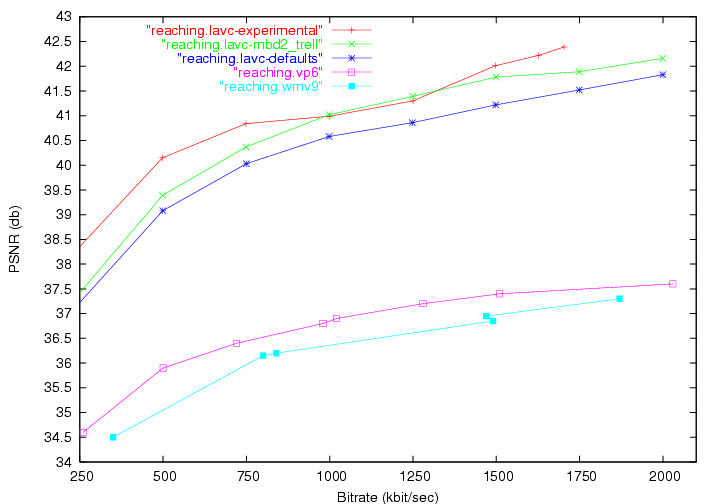I encoded at 200, 300, 400, 500, and 600 kbit/sec. The ratecontrol has trouble below 300, but does well otherwise. The experimental set does very well here, but not in the other tests.

I couldn't find the source numbers used to create the graphs at On2, so I had to "eyeball" them to derive the values to plot on my own graphs. I probably made mistakes. Tell me: bugfood[dash]ml[at]fatooh[dot]org
lavc-mbd2_trell has mbd=2:trell added to the lavcopts.
In my experience, these two are rather safe always-a-benefit options for increasing quality (though, there is an encoding fps hit).
lavc-experimental has some options I wanted to include for testing, out of personal curiosity:
mbd=2:mv0:trell:cbp:precmp=2:cmp=2:subcmp=2:vmax_b_frames=1:predia=2:dia=2:preme=2:vme=5:naq:v4mv
I used 2-pass encoding because lavc always manages ratecontrol better on the second pass. The VP6 white paper(pdf) (on page 16) mentions that using 2-pass with WMV9 produces worse results, and with VP6 makes little difference, so I think it's still fair to compare 2-pass lavc to the other codecs at 1-pass.
These clips are very short, which is why I set vratetol=100. This makes lavc obey the requested bitrate more strictly, rather than the default tolerance of 8000 kbits.
"Mobile"
Source 89MB
I encoded at 200, 300, 400, 500, and 600 kbit/sec. The ratecontrol has trouble below 300, but does well otherwise. The experimental set does very well here, but not in the other tests.

"Reaching"
Source 111MB
I encoded with bitrate from 250 to 2000, at intervals of 250 kbit/sec. The experimental set gets weird above ~800, but the other two lavc encodes perform quite nicely.

"Fence"
Source 50MB
This one is from 200 to 2300, at intervals of 300 kbit/sec. Again, the experimental set gets weird, so don't pay attention to it. The other two lavc sets really shine here too.

"Football"
Source 290MB
I encoded bitrates from 400 to 1500, at intervals of 100 kbit/sec. The source is very difficult (688x480, 24bpp, 29.970 fps, and lots of high detail and fast motion), and lavc just can't really handle below 700kbit/s. In practice, encoding such a clip at these rates would result in unreasonably low quality anyway.
